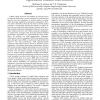Free Online Productivity Tools
i2Speak
i2Symbol
i2OCR
iTex2Img
iWeb2Print
iWeb2Shot
i2Type
iPdf2Split
iPdf2Merge
i2Bopomofo
i2Arabic
i2Style
i2Image
i2PDF
iLatex2Rtf
Sci2ools
ISCA
2005
IEEE
2005
IEEE
Opportunistic Transient-Fault Detection
CMOS scaling increases susceptibility of microprocessors to transient faults. Most current proposals for transient-fault detection use full redundancy to achieve perfect coverage while incurring significant performance degradation. However, most commodity systems do not need or provide perfect coverage. A recent paper explores this leniency to reduce the soft-error rate of the issue queue during L2 misses while incurring minimal performance degradation. Whereas the previous paper reduces soft-error rate without using any redundancy, we target better coverage while incurring similarly-minimal performance degradation by opportunistically using redundancy. We propose two semi-complementary techniques, called partial explicit redundancy (PER) and implicit redundancy through reuse (IRTR), to explore the trade-off between soft-error rate and performance. PER opportunistically exploits low-ILP phases and L2 misses to introduce explicit redundancy with minimal performance degradation. Becaus...
| Added | 25 Jun 2010 |
| Updated | 25 Jun 2010 |
| Type | Conference |
| Year | 2005 |
| Where | ISCA |
| Authors | Mohamed A. Gomaa, T. N. Vijaykumar |
Comments (0)

